by Sheila Dunning | May 13, 2014
Last summer’s heavy rain and the stress of January’s icy weather have contributed to widespread outbreaks of Take-All Root Rot, a soil-inhabiting fungus Gaeumannomyces graminis var. graminis that causes yellow grass patches ranging in diameter from a few inches to more than 15 feet. The symptoms first appear in the spring, but disease can persist all summer and survive the winter. Over time the entire area dies as the root system rots away.
![[Click thumbnail to enlarge.]](https://edis.ifas.ufl.edu/LyraEDISServlet?command=getThumbnailImage&oid=10886581)
![[Click thumbnail to enlarge.]](https://edis.ifas.ufl.edu/LyraEDISServlet?command=getThumbnailImage&oid=9033591)
The pathogen is naturally present on warm-season turfgrass roots. High rainfall and stressed turfgrass trigger the disease. Because the roots are affected, they are not able to efficiently obtain water or nutrients from the soil, nor are they able to store the products of photosynthesis, which result in the loss of color in the leaves. By the time the leaf symptoms appear, the pathogen has been active on the roots for several weeks, probably longer; potentially years. If the turfgrass is not stressed, leaf symptoms may never be observed.
![[Click thumbnail to enlarge.]](https://edis.ifas.ufl.edu/LyraEDISServlet?command=getThumbnailImage&oid=6143337)
This disease is very difficult to control once the above-ground symptoms are observed. Measures that prevent or alleviate stress are the best methods for controlling the disease. Any stress (environmental or man-made) placed on the turf weakens it, making it more susceptible to disease. Remember, that every maintenance practice, fertilizer application, and chemical (especially herbicide), application has an impact on turfgrass health.
Cultural practices that impact the level of stress experienced by a lawn include: proper turfgrass species selection; mowing at the correct height; irrigation timing, frequency and volume; fertilizer nitrogen and potassium sources and application quantities; thatch accumulation; and soil compaction issues. The selection of turfgrass species should be based on existing soil pH, sunlight exposure, use of the area and planned maintenance level.
Mower blades must be sharp to avoid tearing of the leaves. Additionally, turfgrasses that are cut below their optimum height become stressed and more susceptible to diseases, especially root rots. When any disease occurs, raise the cutting height. Scalping the grass damages the growing point. Raising the cutting height increases the green plant tissue available for photosynthesis, resulting in more energy for turfgrass growth and subsequent recovery from disease. If an area of the lawn has an active fungus, washing or blowing off the mower following use will reduce the spread of the disease to unaffected areas.
The amount of water and the timing of its application can prevent or contribute to disease development. Most fungal pathogens that cause leaf diseases require free water (rainfall, irrigation, dew) on the leaf to initiate the infection process. Irrigating every day for a few minutes is not beneficial for the turfgrass because it does not provide enough water to the root zone, but it is beneficial for turfgrass pathogens. It is always best to irrigate when dew is already present, usually between 2 and 8 a.m., and then only apply enough water to saturate the root zone of the turfgrass.
Excessively high nitrogen fertility contributes to turfgrass diseases. The minimum amount required for the grass species should be applied. Potassium (K) is an important component in the prevention of diseases, because it prevents plant stress. Application of equal amounts of nitrogen and potassium is recommended for turfgrass health. When turfgrass roots are damaged from disease, it is beneficial to apply nutrients in a liquid solution. However, nitrate-nitrogen increases the severity of diseases, so their use should be avoided when possible. Ammonium-containing fertilizers are the preferred nitrogen sources. Heavy liming has also been linked to increases in Take-All Root Rot. Since most turfgrasses can tolerate a range of pH, maintaining soil at 5.5 to 6.0 can suppress the development of the pathogen. When the disease is active, frequent foliar applications of small amounts of nutrients is necessary to keep the turfgrass from declining.
Additional maintenance practices that need to be addressed are thatch removal and reduction of soil compaction. Excessive thatch often causes the mower to sink which can result in scalping and reducing the amount of leaf tissue capable of photosynthesizing. Thatch and compacted soil prevent proper drainage, resulting in areas remaining excessively wet, depriving root systems of oxygen.
Since recovery of Take-All – damaged turfgrass is often poor, complete renovation of the lawn may be necessary. Removal of all diseased tissue is advised. As a native, soil-inhabiting pathogen, Take-All-Root-Rot cannot be eliminated. But, suppression of the organism through physical removal followed by proper cultivation of the new sod is critical to the establishment of a new lawn. Turfgrass management practices, not chemicals, offer the best control of the disease.
It is acceptable to use fungicides on a preventative basis while rooting in the sod. Azoxystrobin, fenarimol, myclobutanil, propiconazole, pyraclostrobin, thiophate methyl, and triadimefon are all fungicides that can be utilized to prevent disease development while having to excessively irrigate newly laid sod. Ideally, the turf area should be mowed and irrigated prior to a fungicide application. Unless the product needs to be watered in, do not irrigate for at least 24 hours after a chemical treatment. Do not mow for at least 24 hours, to avoid removal of the product attached to the leaf blades.
Now that we have added another major stress with the recent heavy rain, it will be very important to continue monitoring the turf and being cautious about the cultural practices being used. Take-All Root Rot is likely to flourish. Do not encourage its development.
by Julie McConnell | May 3, 2014
The last week of April 2014 brought with it 10-22 inches of rain across the panhandle in a matter of days. Some areas had immediate flooding and standing water, while others may be in areas at risk of rising rivers and streams. As the water recedes, many people are wondering how all the water will affect their landscapes.
Only time will tell what the long term impact will be, but here are a few things to watch for and what you can do to try to moderate damage.
- Let soils dry out before driving vehicles or other equipment on grassy areas. Even if the water is not visible, if the soil is still saturated, driving lawn equipment or cars may cause ruts.
- Do not leave automatic irrigation systems running on established shrubs, trees, and lawns. If your system is set to run in the early morning hours, you may not think about it being on, check your systems and hold off on adding water until soils dry out and the plants need it.
- Watch for fungus symptoms and treat if needed. Wet plants and cool weather are ideal for some Brown Patch on lawns, be aware and monitor landscapes closely. If disease is suspected, contact your local county extension office for recommendation.
- When mowing, leave a longer leaf blade to compensate for root stress.
- Look at the base of trees and shrubs to make sure silt and sand have not buried the crown or root flare. Also look for erosion of root zone, these areas may need correction. “Salvaging Flood-Damaged Shrubs and Ornamentals.”
- Adjust fertilization as needed; if you recently applied fertilizer it has likely runoff or leached from the site. However, if you suspect fungal disease do not fertilize until disease is managed.
- Stress in turfgrass, for details read “Watch Turf for Flooding Stress”
- You may see new weeds (seeds or segments may have washed or blown into your yard)
- Tree and shrub decline or death read “We Had Plenty of Rain, Why are My Trees Dying?”
- Although this storm was not a hurricane, “Assessing Damage and Restoring Trees After a Hurricane” has helpful information for areas with wind damage
- Nutritional deficiency symptoms in palms may show up 4-5 months from now. “Nutrient Deficiencies of Landscape and Field-grown Palms in Florida.”
- Decreased availability and increased price of sod (flooded fields prevent harvest and increase inputs for disease, weed, and nutrition management)
- Scheduling changes or maintenance adjustments by landscape contractors. Turfgrass and ornamentals will likely need different maintenance applications than in years past to correct issues related to flooding and excess rain.
by Taylor Vandiver | Apr 29, 2014
Now that spring has finally sprung and summer is well on its way, you may find yourself taking a stroll through your landscape and assessing damage done by late cold spells. However, it may not be a frost problem that has your plants looking worse for the wear. They could be experiencing nutritional imbalances which affect overall plant health. Most cases involving nutrition issues in plants can be linked back to the soil. Therefore, if you suspect a problem I suggest testing your soil to ascertain pH and nutrient levels. You can obtain a soil test kit at your local UF IFAS Extension office. Another way to diagnose your plant damage is to visually catalog its symptoms. Symptoms of mobile nutrients, such as nitrogen and phosphorus, tend to reveal themselves on older leaves first. Whereas, immobile nutrient symptoms (i.e. boron and calcium) will show up on newer leaves. These flow charts can help to narrow down which essential element may be lacking in your plant’s diet.
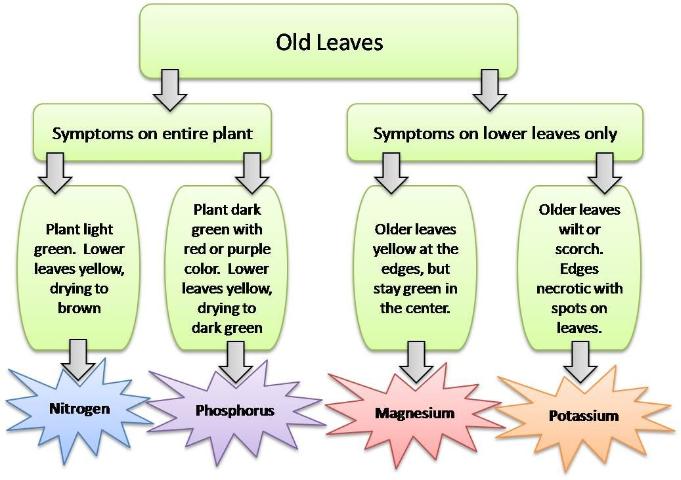
Mobile Nutrient Symptoms.

Immobile Nutrient Symptoms.
by Matthew Orwat | Apr 8, 2014
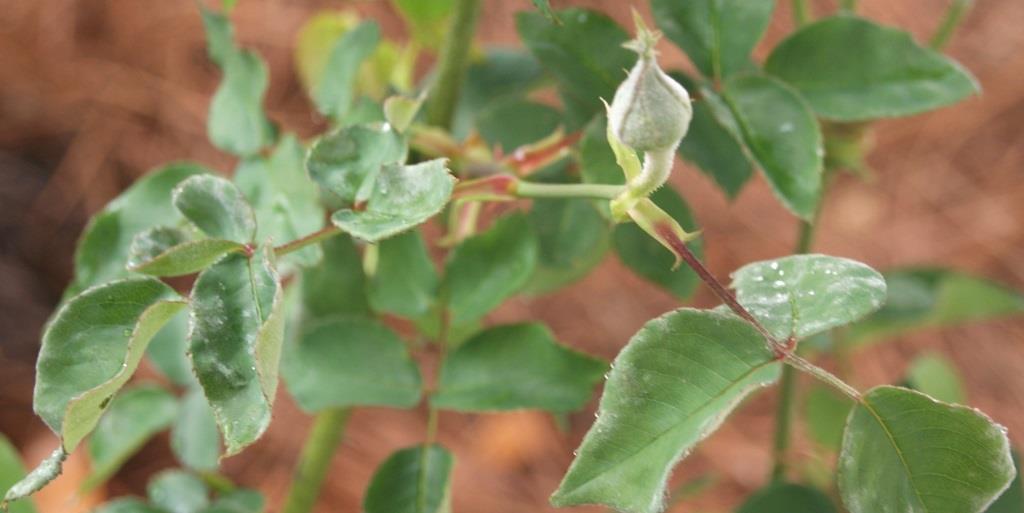
Powdery mildew on rose bud. Image Credit Matthew Orwat.

Powdery mildew on rose leaf. Image Credit Matthew Orwat.
This spring powdery mildew has been prevalent on many non-resistant cultivars of ornamental plants, particularly rose and crapemyrtle.
Ideal conditions for powdery mildew development, warm days and cool nights followed by rain, have been present for several weeks in Northwest Florida.
This fungus, which looks like powdered sugar and is caused by several different species, appears on new growth and causes distorted and stunted leaf and flower development. It grows in thin layers on the surface of leaves and reproduces by spores.
Mild cases are of little concern, as most plants will grow out of it once environmental conditions change to be less favorable for development of the pathogen. Severe cases can cause distorted growth, leaf drop and flower destruction.
In these cases, fungicide application will protect new growth from this disease. Some lower toxicity fungicides that have been shown to have effectiveness on powdery mildew include neem oil and potassium bicarbonate (otherwise known as Baking Soda).
Sulfur can be used, but cannot be applied when temperatures reach above 90 ° F. Other chemical fungicides, including those containing myclobutanil, or azoxystrobin can be used but products obtained must be labeled for ornamental use. Remember, the label is the law.
Many disease resistant cultivars of rose and crapemyrtle exist, please follow the links provided for more information.
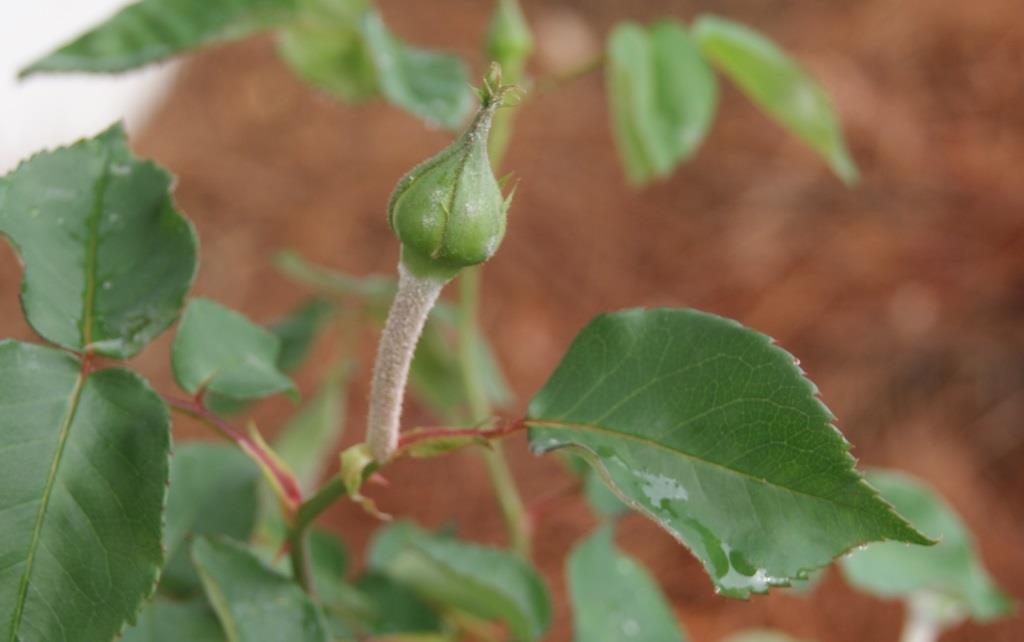
Powdery mildew on rose petiole. Image Credit Matthew Orwat.
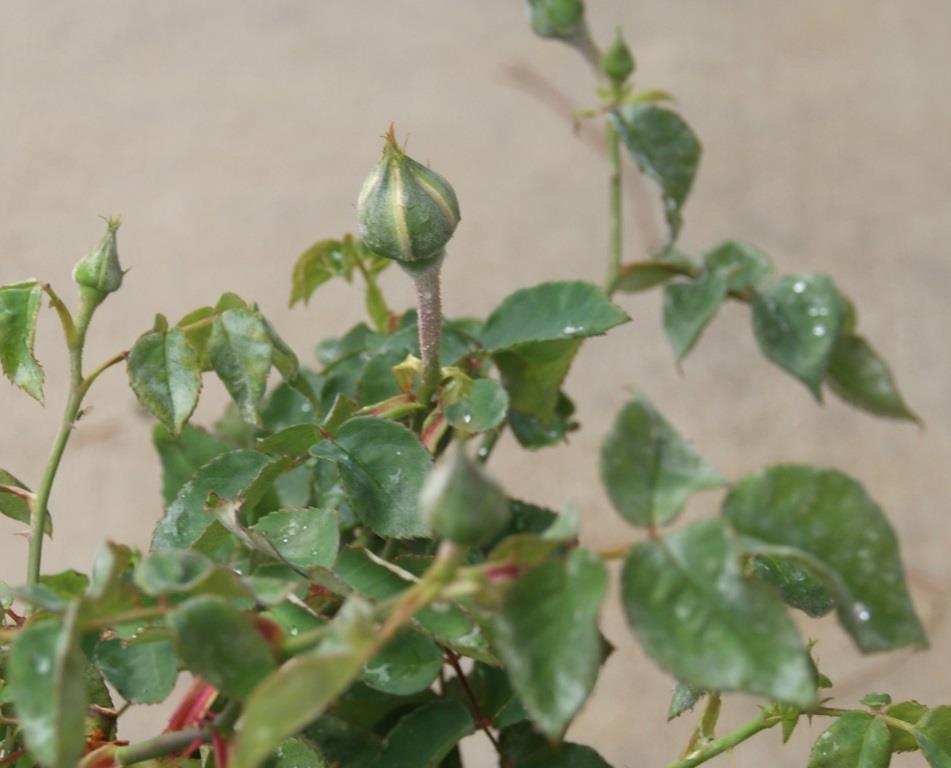
Powdery mildew on rose. Image Credit Matthew Orwat.
by Mathews Paret | Mar 25, 2014
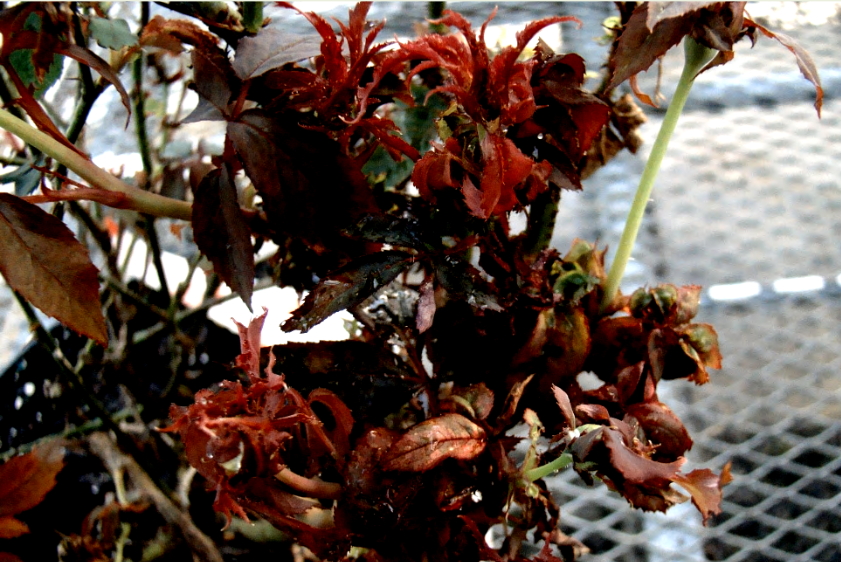
Figure 1. Witches’ broom like appearance, abnormal red discoloration of shoots and foliage, excessive thorns, distorted leaves, and deformed buds and flowers are key symptoms for the devastating Rose Rosette Disease
Roses are one of the most popular flowering shrubs in U.S. with a total wholesale value of 194 million U.S. Dollars. Among the major states in U.S., Florida is the fourth largest producer of roses with a total value exceeding 20 million U.S. Dollars. Among the major diseases on roses, Rose Rosette Disease caused by Rose Rosette Virus (RRV), an Emaravirus has been a major problem for roses in many states in the U.S during the last many years. This virus is spread by an eriophyid mite species Phyllocoptes fructiphilus. This disease was not present in Florida until November 2013, when the disease was first discovered and now confirmed in 3 Florida counties, which include one in the Panhandle. On Wednesday March 19, Horticulturists from throughout the South met at the NFREC in Quincy Florida to discuss detection and control measures that might be used to combat this viral disease.
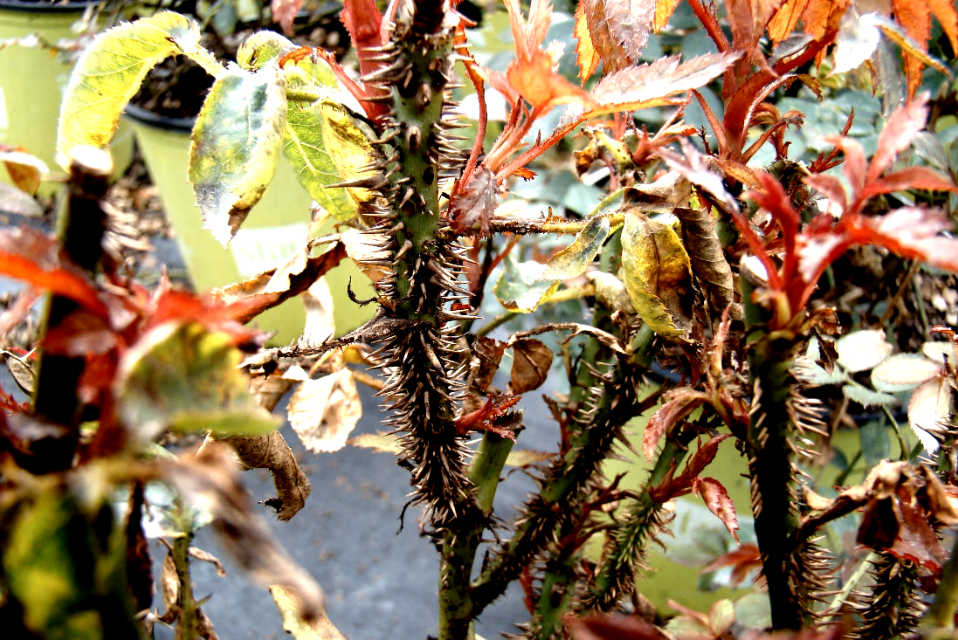
Figure 2. Severe thorn proliferation is another characteristic of rose rosette disease.
The key symptoms for Rose Rosette Disease include witches’ broom, excessive thorns, abnormal red discoloration of shoots and foliage, distorted leaves and deformed buds and flowers (click the link below for symptoms). The diseased plants usually die in 1-3 years. Considering the economic importance of the rose plants, and the highly destructive nature of the Rose rosette virus, research is currently underway by scientists at the University of Florida and the Division of Plant Industry-FDACS to develop early detection methods for the virus and management practices. This project is funded by Florida Nursery Growers and Landscape Association, and the University of Florida, IFAS Dean for Research.
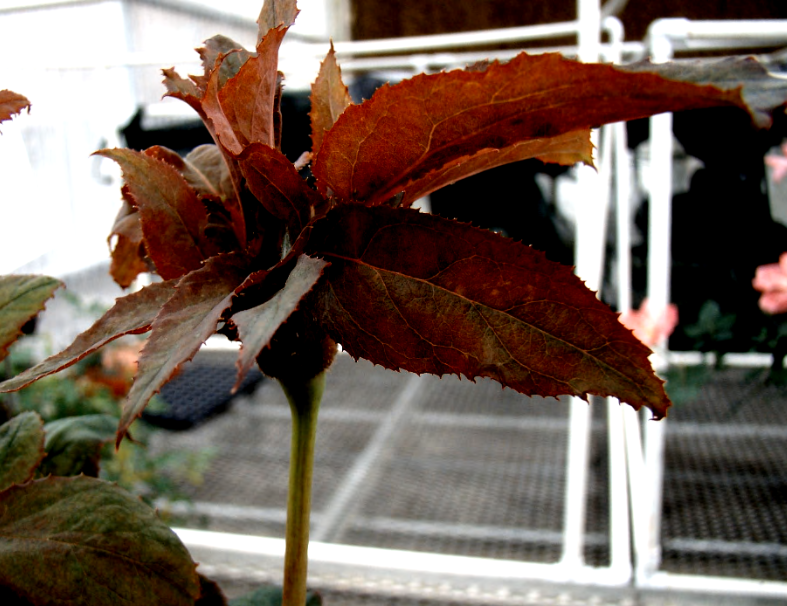
Figure 3. Distorted flower bud; leaf developing from flower bud tissue.
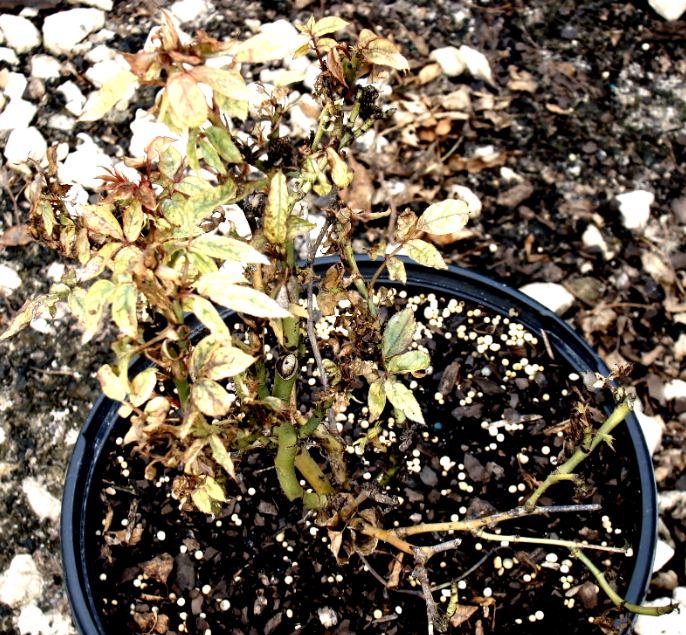
Figure 4. Severe yellowing and stunting of the plant. Infected plants usually die in 1-2 years.
How Home Gardeners and Landscape Professionals Should Respond:
-
Routine scouting and early identification. Submit samples for definitive confirmation.
-
Destroy infected plants. There is no cure for rose rosette disease. Detection will prompt a quarantine by DPI until cleaned up.
-
Eriophyid mite management in early spring is not necessary right now since it has not been found in Florida.
-
Note: The Eriophyid mite species described as the vector for RRV is not known to be present in Florida. Thus mite management recommendations are protective in nature.
Further details can be found in the links below.
U-Scout Pest Alert

by Matthew Orwat | Mar 18, 2014
March may seem a little early to worry about fungal diseases, but recent prolonged wet weather and warmer temperatures have made the climate just right for a variety of leaf diseases in the Florida Panhandle. One in particular, Blackspot (Diplocarpon rosae), is particularly problematic for the discerning rose grower. Blackspot is just beginning to be seen this season on non-resistant rose cultivars throughout the central Florida panhandle.
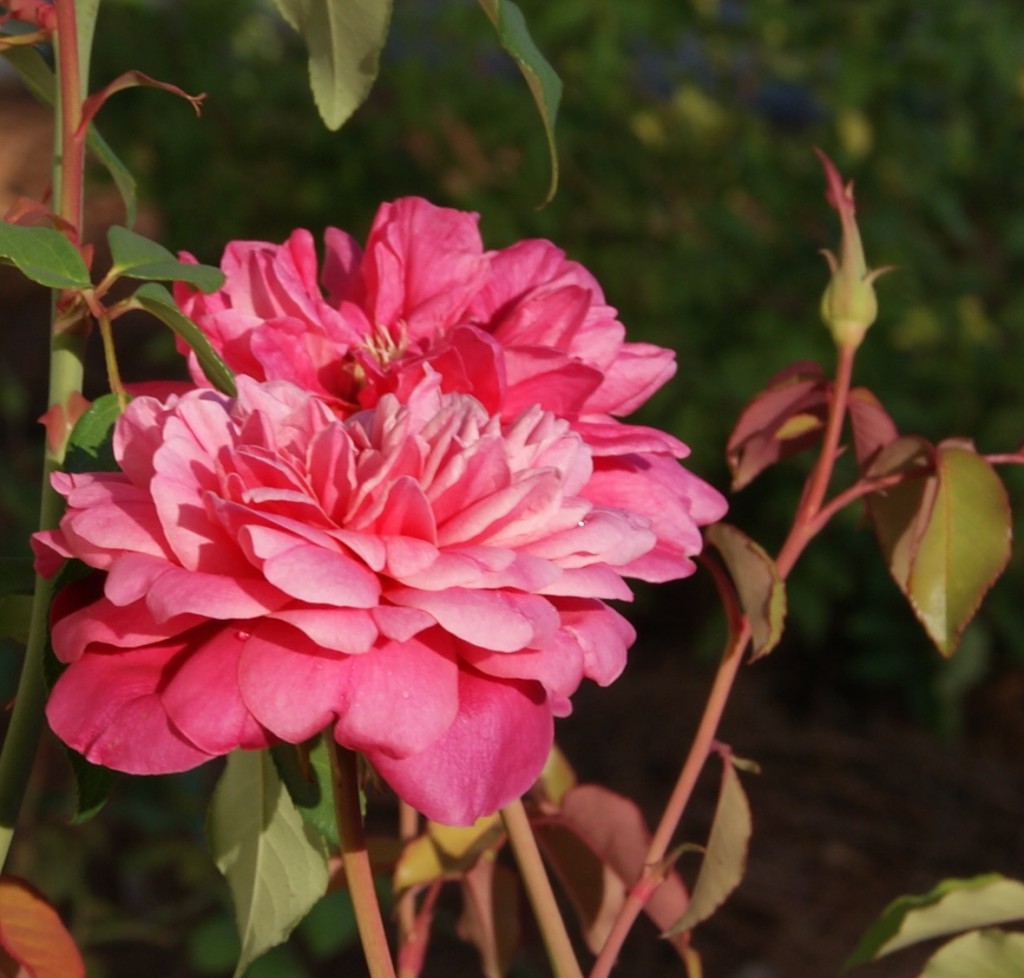
Monsieur Tillier, a rose that shows promise for blackspot resistance, is also part of the Earthkind program. Image Credit Matthew Orwat
Blackspot spores are spread from the canes or leaves of the previous season’s growth by rain or overhead irrigation. To minimize innoculum (black spot spores) remove all leaves from the previous season and any dead leaves at the base of the plant. After the annual pruning in mid to late February, it is a good idea to spray roses with sulfur or copper based fungicidal soap. This helps kill spores that have been laying dormant throughout the winter. Be careful not to spray these products when temperatures rise above 80 ° F. Doing so could burn the plants, although these products will damage tender young growth as well at temperatures below 80 ° F .
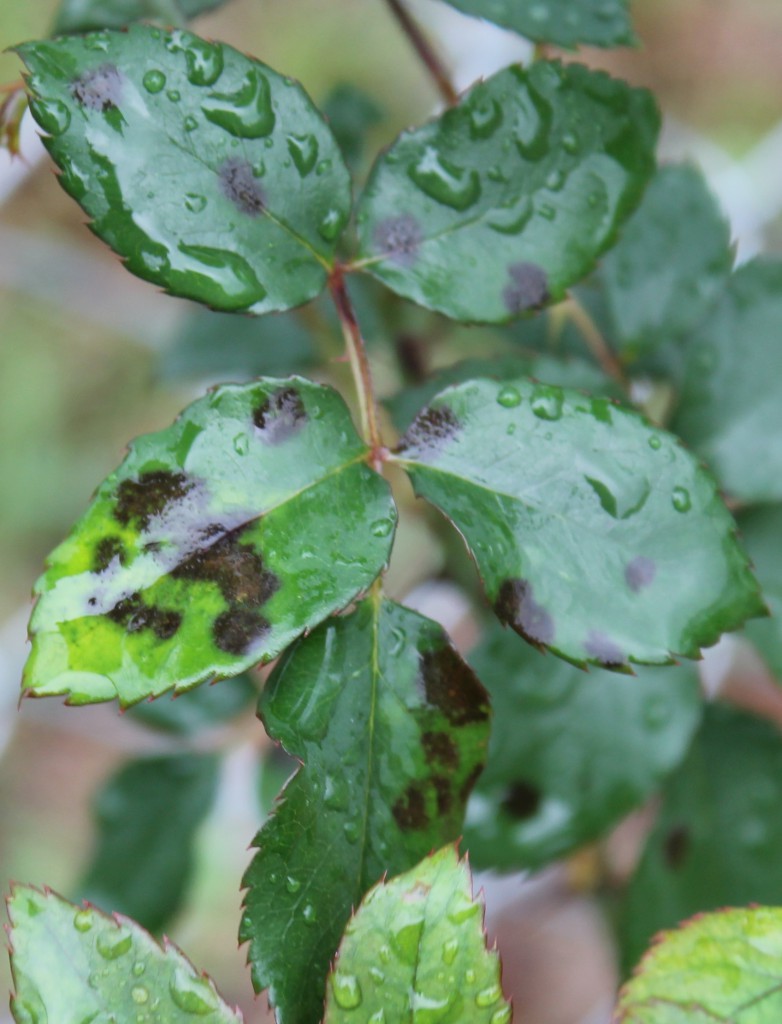
Wet, blackspot affected leaves. Image Credit Matthew Orwat
While dormant sprays often allow rose gardeners to get ahead of the disease, the best defense for the home garden is to plant resistant cultivars. There are several old and new resistant cultivars on the market. Some new resistant cultivars of note include Home Run and Knockout. Also, several older cultivars have demonstrated excellent resistance, such as Mrs. B.R. Cant and Spice. The author has been working with several older rose cultivars at the UF / IFAS Washington County Extension demonstration garden that have shown resistance during the last three years. While this demonstration garden is not a scientific study, several roses that have demonstrated some merit include Belinda’s Dream, Monsieur Tillier, Mme. Antoine Mari, Rosette Delizy and Souvenier de la Malmaison. Another resource for information on disease resistant roses is the Texas Earthkind rose program from Texas A&M University. While disease resistance is not always identical in different parts of the county, their recommended list gives the beginning rose gardener a good place to start.

Mrs. B. R. Cant, a tea rose from 1901 has shown very good blackspot resistance at the UF IFAS rose trials in Quincy, FL. Image Credit Matthew Orwat
Several other cultural methods that will prevent spread of this disease among the rose garden include avoiding overhead irrigation, planting in well ventilated areas and proper plant spacing. These techniques attempt to make the garden environment inhospitable for blackspot proliferation.
Regardless if these management techniques are followed, if traditional large, long-stemmed, high maintenance Hybrid Tea roses are desired, most Florida rose gardeners will need to begin a spray schedule to prevent the onslaught of blackspot. Several fungicides are on the market to aid in this process, but remember that they must be used regularly (every 7-14 days) and modes of action must be rotated. This means that different types of fungicide must be rotated so that resistance to a particular fungicide by the blackspot organism does not develop. Below is a table of recommended fungicides for homeowner blackspot control. For more information, please consult the UF IFAS Extension publication P268, Blackspot of Rose.
Fungicide products marketed toward homeowners for control of black spot on roses
|
Active ingredient
|
Fungicide group
|
Trade name
|
|
Copper hydroxide
|
M1
|
Hi-Yield ® Copper |
|
Copper Sulfate
|
M1
|
Bonide® Copper Dust |
|
Copper Octanoate
|
M1
|
Bonide® Liquid Copper, Natural Guard Copper Soap, Ortho® Disease B Gon® Copper Fungicide |
|
Sulfur
|
M2
|
Bonide® Sulfur Dust, Ferti-lome® Dusting Sulfur, Green Light, Hi-Yield® Dusting Wettable Sulphur, Ortho® Bug-B-Gon® Rose & Flower Care |
|
Mancozeb
|
M3
|
Bonide® Mancozeb |
|
Captan
|
M4
|
Bonide® Captan 50WP, Hi-Yield® Captan 50W Fungicide |
|
Chlorothalonil
|
M5
|
Bonide® Fungonil, Ferti-lome® Broad Spectrum, Hi-Yield® Vegetable, Flower, Fruit and Ornamental Fungicide, Monterey, Ortho® Disease B Gon™ Garden Fungicide , Monterey Fruit Tree, Vegetable & Ornamental Fungicide |
|
Myclobutanil
|
3
|
Spectracide Immunox® Multi-Purpose Fungicide |
|
Propiconazole
|
3
|
Ferti-lome® Liquid Systemic Fungicide, Monterey Fungi-Fighter |
|
Tebuconazole
|
3
|
Bayer Advanced™ Disease Control for Roses, Flowers & Shrubs |
|
Tebuconazole + Imidacloprid
|
3 +
|
Bonide® Rose RX Systemic Drench, Feti-lome® 2-N-1 Systemic |
|
Triforine
|
3
|
Ortho® RosePride® Disease Control |
|
Calcium Polysulfide
|
NC
|
Hi-Yield® Lime Sulfur Spray |
|
Neem Oil
|
NC
|
Bonide® RX 3 in 1, Green Light® Neem Concentrate, Green Light® Rose Defense®, Monterey |
|
Acetamiprid + Triticonazole
|
NC + 3
|
Ortho® Bug B Gon® Insect & Disease Control |
|
Acephate + Resmethrin + Triforine
|
NC + NC + 3
|
Ortho® RosePride® Insect, Disease & Mite Control |
| Fungicide Group (FRAC Code): Numbers (1-37) and letters (M) are used to distinguish the fungicidal mode of action groups. All fungicides within the same group (with same number or letter) indicate same active ingredient or similar mode of action. This information must be considered in making decisions about how to manage fungicide resistance. M=Multi-site inhibitors, fungicide resistance is low; NC= not classified. Source: http://www.frac.info/ (Fungicide Resistance Action Committee, FRAC).
Always read a current product label before applying any chemicals.
|














